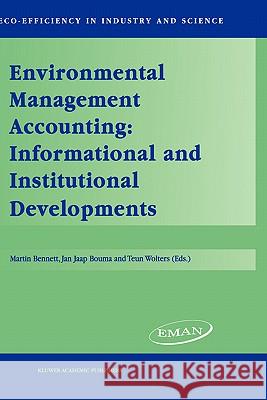Environmental Management Accounting: Informational and Institutional Developments » książka
Environmental Management Accounting: Informational and Institutional Developments
ISBN-13: 9781402005527 / Angielski / Twarda / 2002 / 302 str.
Environmental Management Accounting: Informational and Institutional Developments
ISBN-13: 9781402005527 / Angielski / Twarda / 2002 / 302 str.
(netto: 576,41 VAT: 5%)
Najniższa cena z 30 dni: 578,30 zł
ok. 22 dni roboczych
Bez gwarancji dostawy przed świętami
Darmowa dostawa!
Environmental Management Accounting (EMA) is increasingly recognised as a distinguished tool of environmental management. It helps to integrate a company's environmental and business interests, whereby enhancing corporate eco-efficiency in terms of reducing environmental costs or making one's product more competitive. This book gives a comprehensive coverage of the state of the art. It presents a number of EMA frameworks that companies can take as a basis for implementing their own specific EMA structures. Besides discussing environmental accounting issues within conventional management accounting, it gives a detailed picture of materials flow (cost) accounting as an alternative way of looking at the ecology-economy relationships at the corporate level. A fascinating case study shows how a large company (Siemens) applies materials flow accounting and what benefits it entails. Applying EMA in an effective way may require the use of information systems. The book discusses the pros and cons of different strategies in this area: one may opt for a total integrated solution, partially integrated solutions or for a stand-alone system.
Governments may have good reasons to promote the application of EMA. The use of economic instruments to internalise environmental externalities (norms, ecotaxes and tradable permits) can be much more effective if the incentives they produce are not frustrated by a lack of adequate cost accounting. EMA can be of great importance here. The book discusses a number of these issues, gives information on how international and national organisations (such as in Japan) have taken steps to promote the adoption of EMA by the business community. A final section presents a number of different topics such as how environmental costs can be of help in defining environmental management strategies, how to take environmental performance indicators a step further by developing sustainability indicators for product chains. A final chapter explores a possible theoretical foundation for research on why, how and to what extent companies adopt EMA. Such research may help to turn available insights as to what EMA should be into effective EMA strategies.
The book has been developed under the auspices of the Environmental Management Accounting Network (EMAN-EU). The chapters derive from a selection of papers presented at different EMAN meetings. The authors comprise a truly international group of EMA experts, among whom are the most prominent ones in the field.











